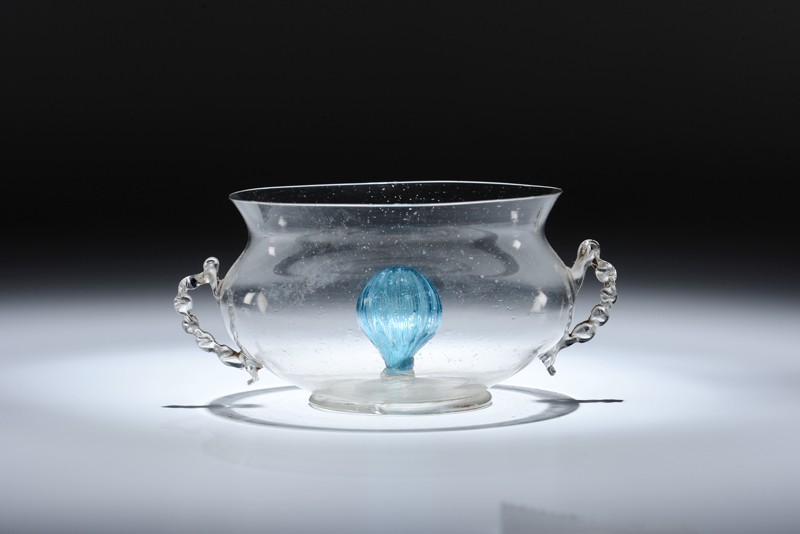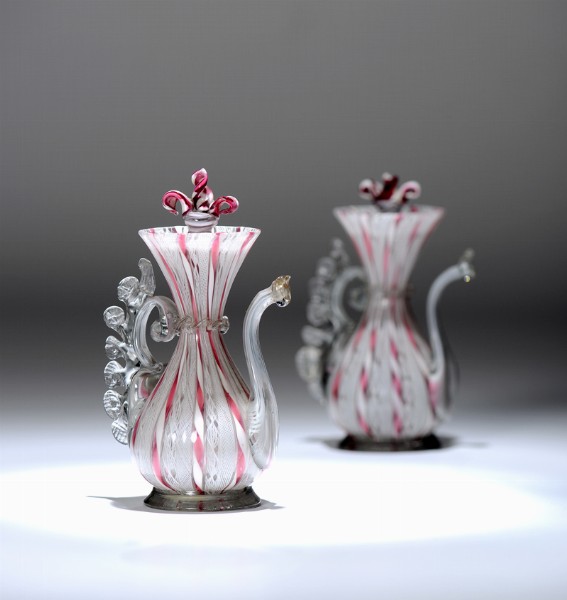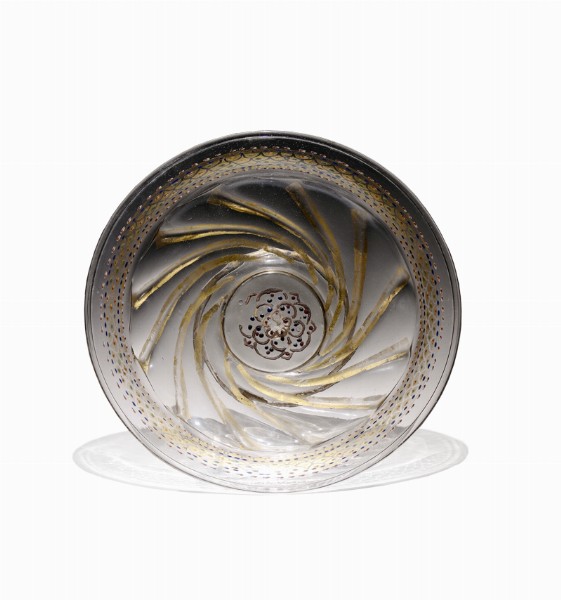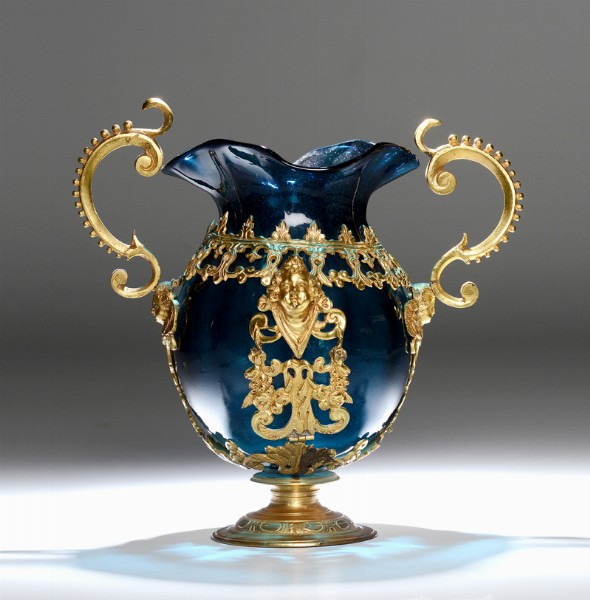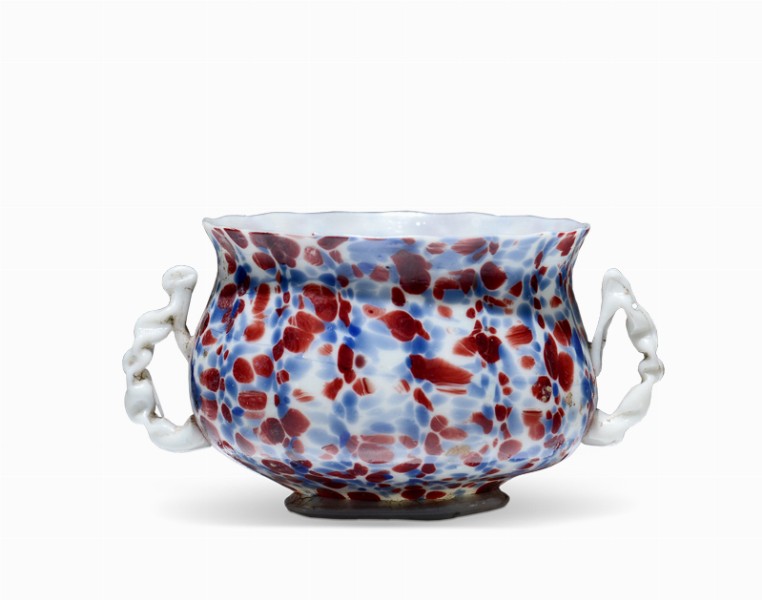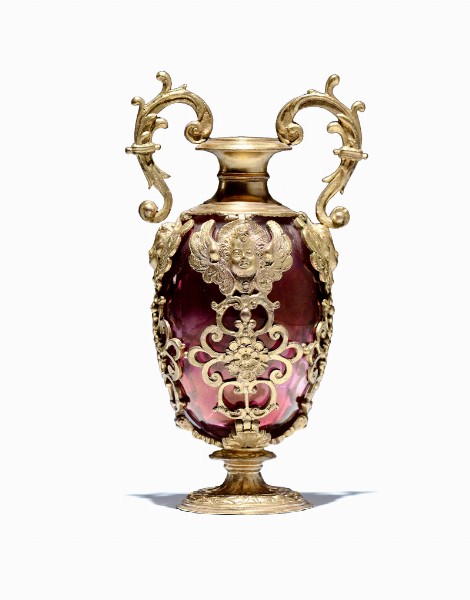Margherita Gobbi
Glass collectors rarely have such a greedy opportunity as the auction that will be held in the second half of October: it has been long, in fact, since the Italian and international markets, always stingy with important Venetian glasses and even more in recent years, have offered such rare, selected and prestigious items.
Among the approximately two hundred pieces, a large number consists of Venetian and à la façon de Venise blown glass, ranging from the early 16th century to the first half of the 17th century, with an appendix of Central European glasses of the 18th century. In broad overview that includes 16th-century balusters, reticelli, glass pens, stained lattimo, blown engraved glasses with a diamond tip, cups and buckets threaded with aquamarine glass, it is worth mentioning some examples of absolute excellence such as the cup and the tazza dating back to the early 16th century, decorated in polychrome enamels and gold patterned points; the tazza is particularly elegant, because of the vortex veining on the plate.
The group of Medicean glasses with gilt bronze mountings, made in Florence or Pisa in the late 16th and early 17th century, is spectacular and very rare, both in private collections and in the public ones. It is formed by a blue glass vase with polylobed embouchure, a red one and a pair of small colorless glass jugs; mountings are decorated with heads of putti, cherubs and fruit garlands. The four items were exhibited in Paris in 2013 in the exhibition “Fragile”. It is also worth mentioning the pair of “pilgrim” flasks with the Bernardinian trigram painted in the middle, these too dating back to the late 16th century.
Moreover, many other glasses are worthy of attention. I will just mention the rich and beautiful set of large bowls on foot, ribbed at the bottom and decorated with strings of aquamarine glass; unique is the one with a thread in amber glass at the base. Let’s mention then the small and precious tazzas, one in reticello glass and another blown into a mold with rhomboid motifs with node highlighted in gold; the numerous chalices, among which the one with the lozenges knot, another shaped like reeds in lattimo glass and the beautiful chalice with polylobed bowl decorated with loops in aquamarine glass; small cups engraved with a diamond tip, as the large tazza with a central conveyor chain in blue glass. Nor we can neglect the rare small bowl in lattimo glass stained in red and blue with pliers handles (among the few known I report the one, identical, of the Poldi Pezzoli Museum) and, between the pens and festoons glasses, the Spanish ones and the delicious jug threaded in blue glass.
We should stop here, also to let visitors free of discovering the many other real surprises that the auction reserves, not only among the masterpieces, but also between the less refined and of common use glasses, or between the more specific one, as the devotional glasses – reliquaries and “bottles of the manna” – and the pharmacy glasses.
Glass collectors rarely have such a greedy opportunity as the auction that will be held in the second half of October: it has been long, in fact, since the Italian and international markets, always stingy with important Venetian glasses and even more in recent years, have offered such rare, selected and prestigious items.
Among the approximately two hundred pieces, a large number consists of Venetian and à la façon de Venise blown glass, ranging from the early 16th century to the first half of the 17th century, with an appendix of Central European glasses of the 18th century. In broad overview that includes 16th-century balusters, reticelli, glass pens, stained lattimo, blown engraved glasses with a diamond tip, cups and buckets threaded with aquamarine glass, it is worth mentioning some examples of absolute excellence such as the cup and the tazza dating back to the early 16th century, decorated in polychrome enamels and gold patterned points; the tazza is particularly elegant, because of the vortex veining on the plate.
The group of Medicean glasses with gilt bronze mountings, made in Florence or Pisa in the late 16th and early 17th century, is spectacular and very rare, both in private collections and in the public ones. It is formed by a blue glass vase with polylobed embouchure, a red one and a pair of small colorless glass jugs; mountings are decorated with heads of putti, cherubs and fruit garlands. The four items were exhibited in Paris in 2013 in the exhibition “Fragile”. It is also worth mentioning the pair of “pilgrim” flasks with the Bernardinian trigram painted in the middle, these too dating back to the late 16th century.
Moreover, many other glasses are worthy of attention. I will just mention the rich and beautiful set of large bowls on foot, ribbed at the bottom and decorated with strings of aquamarine glass; unique is the one with a thread in amber glass at the base. Let’s mention then the small and precious tazzas, one in reticello glass and another blown into a mold with rhomboid motifs with node highlighted in gold; the numerous chalices, among which the one with the lozenges knot, another shaped like reeds in lattimo glass and the beautiful chalice with polylobed bowl decorated with loops in aquamarine glass; small cups engraved with a diamond tip, as the large tazza with a central conveyor chain in blue glass. Nor we can neglect the rare small bowl in lattimo glass stained in red and blue with pliers handles (among the few known I report the one, identical, of the Poldi Pezzoli Museum) and, between the pens and festoons glasses, the Spanish ones and the delicious jug threaded in blue glass.
We should stop here, also to let visitors free of discovering the many other real surprises that the auction reserves, not only among the masterpieces, but also between the less refined and of common use glasses, or between the more specific one, as the devotional glasses – reliquaries and “bottles of the manna” – and the pharmacy glasses.
